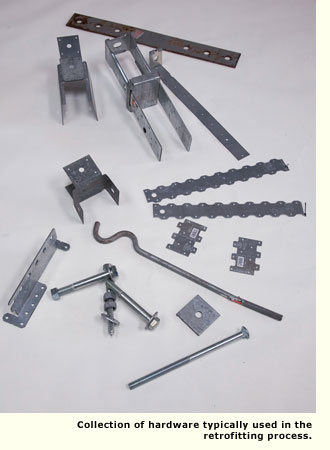Shake, Rattle...and Retrofit - Page 3
Add strength to your roof by installing a roof diaphragm made of solid plywood sheathing that works similarly to the shear bracing method. The roof diaphragm will gather the energy generated by an earthquake at the top of the structure and direct it through the vertical shear panels into the ground. It makes sense to do this project only when re-roofing your home. A bonus benefit to this project is that the added plywood also provides an extra layer of insulation.
It's wise to nail down anything that can move during an earthquake, including major plumbing equipment. "The single biggest plumbing problem is the water heater," Pryor says. "In an earthquake, the horizontal shaking can generate fairly large loads."
Mount metal straps around the top and bottom of your water heater and bolt the straps securely to the concrete wall or studs. Block in any gaps between the back of your water heater and the wall. Install an automatic gas shut-off valve at the gas meter, if it doesn't have one already, and know where your water shut-off is in case of emergency.
It's tough to put a price on the cost of retrofits, since each home has its own quirks. A medium-sized home that sits directly to the foundation, as MCM homes do, can have connection improvements installed for $3,000 to $6,000, according to contractors at Earthquake Safety. If you opt to do it yourself, you can cut those costs significantly.
Although many homeowners would rather spend money on home improvements they can see and enjoy day-to-day, such as a new kitchen, open floor plan, or expanded back patio, seismic improvements should be part of regular home maintenance.

Property experts say it's tough to see a direct correlation between doing seismic retrofits and an increased value of a home. When buying a home, realtors do suggest having any previous seismic improvements inspected as part of the overall home inspection by calling a qualified structural engineer.
Pryor says its pays off to invest in both retrofits and insurance. "I do have earthquake insurance, and in an informal poll of people I've done, they say the money spent on retrofits is well worth it," he says. "It has a noticeable impact on the safety of your building."
With the passage of state proposition 13 in June 2010, California law now prohibits tax assessors from re-evaluating new construction for property tax purposes when the point of the new construction is to seismically retrofit an existing building.
Often, the best time to do earthquake retrofits is during larger home remodeling projects. "When you are opening up walls, it creates an opportunity to do seismic retrofits," Key says. "When you have a strong foundation and the walls are properly attached to it, it allows the walls to flex and snap back like a rubber band would."
Do the simplest seismic improvements first and stage others as you have the time and budget to do them—but you should do them. A home won't experience all the benefits of a retrofit until all the recommended improvements are completed. Some building departments, says Key, do not mandate seismic improvements if you're doing limited projects, and most local building departments won't issue permits for seismic improvements unless it's part of a bigger project. Many city building departments will send out an inspector to review the completed work to ensure that it's been done well—by inspecting the bolts and hardware that were attached, and the type of plywood and the nailing method used for sheer improvements.
"If your scope of work is a kitchen or bathroom remodel, and you are not moving walls, you are not required by code to improve these houses," Key says. "As soon as you change something, like removing a post, adding a wall, or making an addition, you are oftentimes required to send changes to an engineer."
John Ortiz improved the structural strength of his 2,100-square-foot Palo Alto Eichler when he and his family signed on for a remodel with Keycon. "It started as a general remodel that moved into a kitchen and house upgrade, and that opened up the great room," Ortiz explains. "Ron [Key] took the opportunity and suggested that we seismically retrofit the house while we were at it."
"At John's house, we did some basic things we could do because we had the walls open and the foundation exposed," Key says. "We were able to bolt into the foundation and strap the posts and beams into the foundation, and we did a sheer wall of the exterior as well."
Both Ortiz and Key said it's hard to quantify how much the seismic improvements cost in this project because they were wrapped into the overall cost of the remodel. "Percent-wise it wasn't huge," Ortiz says. "It made sense to us—since we're in earthquake country, and since our house hadn't been seismically upgraded—to make the investment while we had the walls open."




